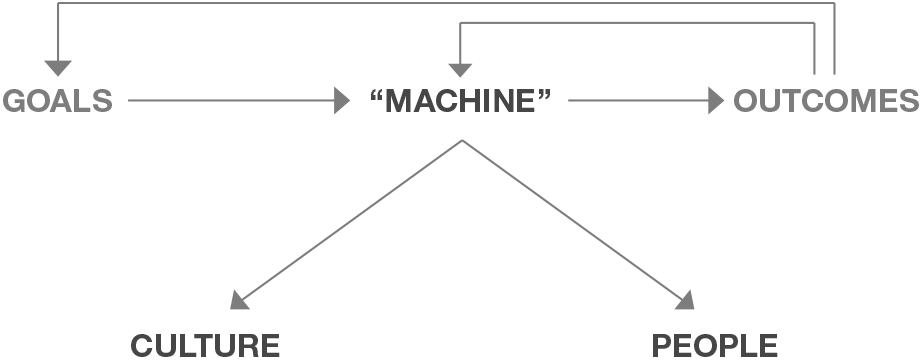My Management Principles
In Part 1 I explained why I believe having principles is important and that I believe that it is up to each person to decide what principles are best for them. In Part 2 I explained my most fundamental principles. In this part I explain my management principles. Naturally, my management principles reflect the principles I believe are best throughout my life. But before I get into my particular management principles, I’d like to touch on management principles in general.
If you read any of the earlier parts you know that I believe that having principles is essential for getting what you want out of life. That is as true for groups of people (e.g., companies, schools, governments, foundations, etc.) as it is for individuals. While individuals operating individually can choose whatever values and principles they like, when working in a group the people must agree on the group’s values and principles. If the group is not clear about them, confusion and eventually gravitation toward the population’s averages will result. If the group’s values and principles are clear, their way of being (i.e., their culture) will permeate everything they do. It will drive how the people in the group set goals, identify problems, diagnose problems, design solutions and make sure that these designs are implemented. So I believe this relationship looks like this:
 While having a clearly conveyed great culture is important, that’s only half of the magic formula. The other half is having great people —i.e., people who have the values, abilities, and skills that fit the organization’s culture.
While having a clearly conveyed great culture is important, that’s only half of the magic formula. The other half is having great people —i.e., people who have the values, abilities, and skills that fit the organization’s culture.
In other words, I believe that to have a great company you have to make two things great—the culture and the people . If these two things are great your organization can navigate the twists and turns to get you where you want to go.
Of course, you have to know where you want to go. Organizations, like individuals, have to choose what they are going after (i.e., their goals), which influences their directions. As they move toward their goals, they encounter problems, make mistakes and discover weaknesses. Above all else, how they choose to approach these impediments determines how fast they move toward their goals.
Every organization works like a machine to achieve its goals. This machine produces outcomes. By comparing the outcomes to the goals, those running the machine can see how well the machine is working. This is the feedback loop that those who are responsible for the machine need to run well in order to improve the machine. Based on the feedback, the machine can be adjusted to improve. The machine consists of two big parts—the culture and the people . If the outcomes are inconsistent with the goals, something must be wrong with the machine, which means that something must be wrong with the culture and/or the people. By diagnosing what is wrong, designing improvements and implementing those improvements, the machine will evolve. In short, the evolutionary process is as follows. Take a minute to look it over and see what you think.
 The more frequently and effectively those in the machine go through this process, the more rapidly they and the machine will evolve. An effective evolutionary process looks like this—i.e., lots of quality feedback loops produces a steep upward trajectory.
The more frequently and effectively those in the machine go through this process, the more rapidly they and the machine will evolve. An effective evolutionary process looks like this—i.e., lots of quality feedback loops produces a steep upward trajectory.
 An ineffective evolutionary process—i.e., one in which mistakes are infrequently looked at and weaknesses are not well identified—looks like that shown below, i.e., fewer and/or less effective feedback loops produces a slower upward trajectory. In fact, if there are too few and/or bad quality feedback loops, there will be a decline because you won’t identify and deal with the problems that will kill you.
An ineffective evolutionary process—i.e., one in which mistakes are infrequently looked at and weaknesses are not well identified—looks like that shown below, i.e., fewer and/or less effective feedback loops produces a slower upward trajectory. In fact, if there are too few and/or bad quality feedback loops, there will be a decline because you won’t identify and deal with the problems that will kill you.
 I believe that this is equally true for individuals and organizations. I also believe that the most important difference between great organizations and bad ones is in how well they manage their feedback loops.
I believe that this is equally true for individuals and organizations. I also believe that the most important difference between great organizations and bad ones is in how well they manage their feedback loops.
Bridgewater’s Culture and People
Naturally, the culture and people that I have chosen for Bridgewater are extensions the principles that I believe work best, which I explained in Part 2. Most importantly I value meaningful work and meaningful relationships that are obtained by striving for truth and excellence with great people. I am confident that through this constant striving, we will evolve rapidly together.
As you might have guessed from reading Part 2, I want Bridgewater to be a company in which people collectively:
work for what they want and not for what others want of them.
come up with the best independent opinions they can muster to move toward their goals,
stress-test their opinions by having the smartest people they can find to challenge them so they can find out where they are wrong,
are wary about overconfidence, and good at not knowing
wrestle with reality, experiencing the results of their decisions, and reflecting on what they did to produce them so that they can improve.
And when faced with difficult choices, I want them to see the choices as follows.





While I recognize that being this way is challenging, I am also confident that it is what is required to get the most out of out of life. I am confident for two reasons. First, it is logical that the cause-effect relationships are such that being this way produces good results. Second, this theory has been tested over the last 40 years and has worked. While 40 years ago being this way seemed logical, back then that was an untested theory. Now that we have 40 years of testing to look back on, we can see that the results verify the theory.
Fleshing Out This Way of Being
The best advice I can give you is to ask yourself what do you want, then ask ‘what is true’—and then ask yourself ‘what should be done about it.’ I believe that if you do this you will move much faster toward what you want to get out of life than if you don’t!
Because what I have said is pretty abstract, I need to spell out exactly what it means to run a company this way. I need to get very specific. Over time, I have collected and refined my principles so that they now encompass almost all aspects of management. I believe that virtually all problems you might encounter are addressed by one or more of the principles that follow.
There are too many principles to read this as a book. What follows is not a few rules to go by presented in an easily digestible form that’s easy to remember. That wouldn’t have been specific enough to be of much help to you. There are over 200 principles here that are well-explained and are meant to be used more as a reference book than a book that is read from cover to cover.
I’ve created an outline that serves the purposes of being both a summary of my management principles and a table of contents for a more complete explanation of them. Said differently, these principles are presented in a big picture way in this Summary and Table of Principles and in a more thoroughly explained way in the section that follows. If you want to understand the principles in brief, just read what’s said in the outline (swipe toward the right to pull this outline into view) and if you want to delve into them, go to the individual principles (below).